- Road Station - Echigo Ichiburi no Seki

Road & Geosite Conditions
Fully Accessible

- Number
- Area
- 1. Ichiburi Geosite
- 2. Oyashirazu Geosite
- 3. Omi Coast Geosite
- 4. Omigawa Jade Gorge Geosite
- 5. Imai Geosite
- 6. Itoigawa-Shizuoka Tectonic Line and Salt Trail(North) Geosite
- 7. Maikomidaira Geosite
- 8. Hashidate Gold Mine Geosite
- 9. Kotakigawa Jade Gorge Geosite
- 10. Tsugami Shindo Geosite
- 11. Himekawa Gorge Via Oito Line Geosite
- 12. Itoigawa-Shizuoka Tectonic Line and Salt Trail(South) Geosite
- 13. Himekawa Gorge Geosite
- 14. Renge Geosite
- 15. Itoigawa Coast Geosite
- 16. Miyama Park and Museums Geosite
- 17. Tsukimizunoike Geosite
- 18. Umidani Gorge Geosite
- 19. Amakazariyama Geosite
- 20. Yakeyama Geosite
- 21. Benten-iwa Geosite
- 22. Shindosan Geosite
- 23. Gongendake Geosite
- 24. Tsutsuishi Hamatokuai Geosite
- Jade
- 1. Ichiburi Geosite
- 2. Oyashirazu Geosite
- 3. Omi Coast Geosite
- 4. Omigawa Jade Gorge Geosite
- 9. Kotakigawa Jade Gorge Geosite
- 15. Itoigawa Coast Geosite
- 16. Miyama Park and Museums Geosite
- Fossa Magna
- 5. Imai Geosite
- Itoigawa-Shizuoka Tectonic Line and Salt Trail(North) Geosite
- 11. Himekawa Gorge Via Oito Line Geosite
- 12. Itoigawa-Shizuoka Tectonic Line and Salt Trail(South) Geosite
- 13. Himekawa Gorge Geosite
- 17. Tsukimizunoike Geosite
- 21. Benten-iwa Geosite
- 22. Shindosan Geosite
- 24. Tsutsuishi Hamatokuai Geosite
- Mountainous areas
- 7. Maikomidaira Geosite
- 8. Hashidate Gold Mine Geosite
- 10. Tsugami Shindo
- 14. Renge Geosite
- 18. Umidani Gorge Geosite
- 19. Amakazariyama Geosite
- 20. Yakeyama Geosite
- 23. Gongendake Geosite

Created from volcanic rock during the Cretaceous period (about 100 million years ago), the mountains here press against the coastline. The same geological formations found at Oyashirazu Geosite in the east continue here. In addition to those found in Oyashirazu, serpentine, crystalline schist (dating to the Paleozoic era), and marine fossils (from the Jurassic and Cretaceous periods) are distributed throughout the area.
Constant wave activity along this area's gravel coast provides many naturally polished, hand-sized rock specimens. Many of these rocks have been carried here by deep ocean currents from the Omigawa River and the Himekawa River to the east, and the Sakaigawa River in the west. A determined hunter can find especially beautiful jade along this coast. It's believed that the natural polishing effect of the sea has cleaned the masses of jade pulled down from the mountains to their superior-quality cores.
From the nearby Sakaigawa River, sandstone and mudstone left behind by marine fossils drifts in to Ichiburi. Especially inside dark mudstone, it is possible to find fossils of plants, bivalve mollusks, ammonites, and other marine organisms.
In ancient times, Ichiburi served as a checkpoint and inn town along the old Hokuriku Road, just west of the infamously treacherous cliffs of Oyashirazu. Matsuo Basho, the most celebrated poet of the Edo period, once stopped in an inn here where he wrote the poem "Hitotsu-ya ni, yuujo mo netari, hagi to tsuki," which translates roughly to, "For one night at this inn, prostitutes sleep, as do clovers and the moon."
 Ichiburi Coast
Ichiburi Coast
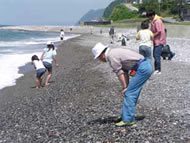
Mountains made of volcanic rocks formed during the Cretaceous period (when dinosaurs roamed the Earth, fall here into the coast. These beaches are gravelly and covered with a variety of rock specimens. With luck (and a lot of searching) you might even find jadeite among them.
 Kaido Pine Tree
Kaido Pine Tree
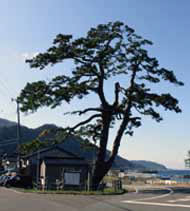
For many generations, this great pine tree has stood at the eastern border of the inn town of Ichiburi. It has long been treated as a landmark by travelers and locals alike. It is here where those traveling on the ancient Hokuriku Road would descend to the shore where they would cross through the Oyashirazu region along narrow, cliffside beaches and raging waves. Likewise, for those traveling west through Oyashirazu, the Kaido Pine was a welcome sight as it marked the end of the perilous seaside pass.
The tree stands at a height of 20m and the trunk is 3.5 meters in circumference at its thickest. Believed to be over 230 years old, the tree is now a city-designated protected natural monument.
 Kikyoya Inn Site
Kikyoya Inn Site
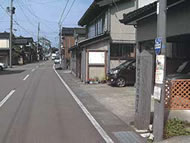
The famous and celebrated seventeenth century poet, Matsuo Basho, stopped at an inn once located here and wrote about it in his famous travelogue, Oku no Hosomichi. While staying at Kikyoya Inn, he wrote a well-known poem, a monument commemorating this poem can be found at nearby Choenji Temple.
Unfortunately, the inn was lost in a devastating fire in 1914. A stone marker was built by the site where the inn once stood.
 Tamanoki Landslide
Tamanoki Landslide
The Tamanoki Landslide happened in the early evening on January 15, 1985. The mountains crumbled as a result of heavy rain and melting snow bringing stone and earth down upon the village below. In the ensuing destruction and fire, 10 people lost their lives and several homes and other buildings were destroyed.
A memorial was built as a silent reminder of those who lost their lives to the frightening indifference of nature.

 Ichiburi Customs Gate and Hackberry Tree
Ichiburi Customs Gate and Hackberry Tree
The Ichiburi Customs Gate was a sekisho, one of many checkpoints constructed by the Tokugawa Shogunate to inspect cargo and control the movement of people and goods throughout the country. Such sekisho helped the Tokugawa Shogunate maintain order and ensured their rule remained uncontested.
This barrier was built in 1624, but was demolished in 1869. A hackberry tree now standing on the grounds of Ichiburi Elementary, was planted to mark the location of this site.

Road Station "Echigo Ichiburi no Seki"
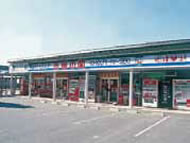
This small roadside station along National Route 8 sits along the cultural border between eastern and western Japan. As such, you can buy products here manufactured in both regions. Many visitors are surprised to learn the differences in flavor between the two halves. For example, instant noodles are flavored more strongly in the East.
The station sells a variety of gifts and locally-produced goods. It also houses a small restaurant specializing in local cuisine.
Poestic monument of Matsuo Basho
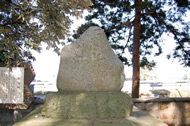
Poetic Monument of Matsuo Basho
Hitotsu-ya ni / Yuujo mo netari / Hagi to tsuki
"Under the same roof, prostitutes also sleep, like clovers and the moon "
This haiku was written by famed poet Matsuo Basho during his stay at an inn here during his famous "Oku no Hosomichi" journey across Japan. Basho was moved to write this poem when he overheard prostitutes on a pilgrimage to faraway Ise Shrine who were also staying at the inn. Looking out his window, he saw the moonlight shining through the bush clover, which to him represented a similar contrast between his traveling party and the women.
Here at Choenji Temple, a stone monument commemorates this poem and Bassho's visit.
Route to Ichiburi Geosite
Destination:

